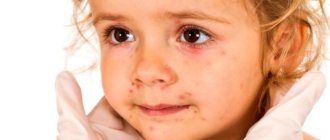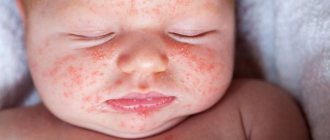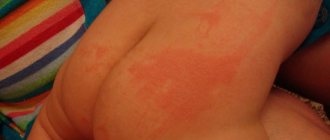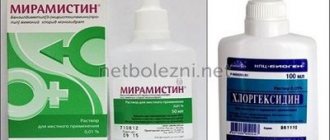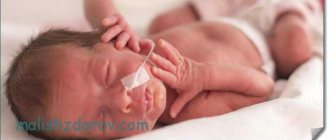Allergic rash in a newborn
An allergy in an infant is an unfavorable immune response of the child’s body to a potentially dangerous substance. Most often, an allergic rash occurs when a nursing mother consumes foods that can act as an irritant. This group includes:
- cow's milk;
- soy [1] and egg white;
- fish;
- strawberry;
- nuts.
The first sign of a developing allergic rash is peeling. Pathological lesions with dry skin on the face of a newborn form symmetrically and are localized on the cheeks and forehead. It is necessary to consult a doctor if the appearance of rashes affects the general condition of the baby. Irritability, restless sleep, gastrointestinal disorders, fever and vomiting are dangerous symptoms that should be stopped immediately under the supervision of a pediatrician.
How a newborn changes
The baby is born, and we expect him to look like the beautiful and pink babies in the advertising pictures. And it is somehow red, then suddenly turns yellow, there is either a rash or peeling on the skin. And in addition, the weight is unstable, the stool is unclear - is the child healthy? Healthy, and all these changes are so-called transient (transitional) states. Where do they come from, what do they look like and what to do with all this?
The child sat in his mother’s belly for nine months, swam in the water and received oxygen through the placenta. As soon as the baby was born, his world immediately became different: instead of water there was air around him, the ambient temperature dropped from 36.6–37 °C to 22–25 °C, plus gravity, sounds, smells, bright light. And now you have to breathe yourself (with your lungs), eat differently, and then remove metabolic products. And just like that, it’s not easy for a newborn to immediately switch from one way of life to another; it takes time. That is why, from a physiological point of view, in the first month of life “something happens all the time” to children, and much more often and more vividly than in later life. These are transient (transitional, borderline) states. All of them surprise and even frighten young parents, especially since transitional states arise and disappear very quickly. But for newborns they are completely natural. What moms and dads most often see are transitional states of changes in skin, stool, weight, plus or minus a couple more conditions.
how skin changes
The child was born, and we see that he is all some kind of bluish-purple, and then the color of his skin immediately turns red. On the second day after birth, the baby “blushes” the brightest. Doctors call this redness “simple erythema,” and it appears because the skin is adapting to a new environment. Then the baby’s skin turns pale and by the end of the first week of life it becomes the usual pale pink color.
But that is not all. On the third to fifth day of life, the baby's skin may begin to peel, especially on the stomach and chest. What is this? Does the child lack vitamins, is there something wrong with the diet, is the air in the house too dry? No, this is also a transitional state - physiological peeling, and it is also due to the fact that the skin adapts to a new life. The skin peels for about a week, and then everything goes away. You don't need to do anything about it. Of course, you can treat the skin with various softening lotions and creams, but they will not have a significant effect. Very soon the baby's skin will become smooth and soft on its own.
What frightens parents most is the rash on the baby’s skin, which does not often, but sometimes still appear in the first week of life. This is the so-called toxic erythema - spots with grayish-yellow compactions in the center. The rash is most often located on the extensor surfaces of the arms and legs, around the joints, and on the chest. Less commonly, such spots can appear on the entire body (except for the palms, feet and mucous membranes). “Maybe it’s chickenpox, rubella or some other disease?” - Parents are scared. No, this is a peculiar reaction of the skin of a newly born child to its environment, especially to hypothermia, overheating, contact with clothing, and nutrition. New spots may appear within one to three days, but more often, two to three days after they appear, they all disappear without a trace. The child’s well-being is not affected, his body temperature is normal and he does not require any medications. The only thing is that you need to be careful about the bubbles on your skin: for example, gently blot them after bathing. You also need to be careful not to rub the blisters and burst them (otherwise they may become infected).
physiological jaundice
The changes visible on the skin do not end there. Very often (in 60–70% of children) the skin turns yellow on the second or third day of life, maximum yellowness occurs on the third or fourth day, and by the end of the first week it disappears. This is how physiological jaundice of a newborn manifests itself - a condition in which the amount of bile pigment, bilirubin, increases in the child. In some children, jaundice will look like a light tan (parents may not notice it), while in others the skin will become a bright yellow color. Very quickly, the bilirubin level returns to normal and the skin color returns to normal. If the jaundice is mild and goes away quickly, then no additional treatment is needed. But if the jaundice does not disappear or the skin color is intensely yellow, you should consult a doctor.
weight loss
Do you think the baby will be born immediately well-fed, with folds and cute roundness? No, immediately after birth this is still a long way off. In the first days of life, an already not very well-fed newborn will lose even more weight. This weight loss is a natural process, the so-called physiological weight loss. Weight decreases because immediately after birth the baby loses some of its water through the skin, its umbilical cord dries out, meconium (the first feces) and urine are released, and also because the baby still eats a small amount of milk. Maximum weight loss usually occurs by the third to fifth day and is normally no more than 6–8% of birth weight. At this time, mother and baby are usually discharged from the hospital, but there is no need to worry. By the seventh to tenth day of life, a healthy baby will restore its previous parameters.
stool changes
On the first or second day, all newborns pass their first stool (meconium): it is thick, viscous and dark green in color. Time passes, the baby begins to receive colostrum, and on the third or fourth day of life, transitional stool appears. Now areas of dark green color alternate with greenish and yellow, and some lumps and mucus are also visible in the stool. This all sounds like some kind of intestinal disorder, but it is not it. The gastrointestinal tract simply switches to a new job, now it is ready to digest food. By the end of the first week of life, most children's stools are yellow and mush-like, and they will continue to be that way.
warm-cold
A typical fear of all grandmothers is that the child is freezing! Yes, indeed, in newborns the processes of regulating body temperature are still imperfect, so babies easily cool down, but they also overheat just as easily. For example, if a newborn is dressed too warmly or placed next to a radiator, he will quickly overheat, even if this is the normal temperature in the room. At the same time, a child easily loses heat when he is undressed for a long time or lies in wet clothes. Therefore, in the room where there is a newborn, the air temperature should be adequate - 20–22 °C. And if she rises higher, and the child is dressed warmly, then this will also be bad.
Sometimes, very rarely (in 1% of children born), body temperature on the third to fifth day can temporarily rise to 38–39 °C. There are no other symptoms of the disease, the body temperature quickly returns to normal, but the parents manage to get scared. It’s difficult to figure out on your own whether it’s temporary hyperthermia or a disease, so it’s better to call a doctor.
hormonal crisis
An infrequent occurrence, but it also occurs sometimes. In some children, on the third or fourth day of life, the mammary glands become engorged (both girls and boys). They increase to their maximum by the seventh or eighth day, and liquid discharge may even appear from them. Some girls sometimes have very scanty bleeding from the vagina for a very short time. This is the so-called hormonal crisis - it occurs due to the action of maternal hormones - estrogens (they penetrate through the placenta during childbirth). At the peak of estrogen action, the signs of a hormonal crisis are maximum, then the hormones are eliminated from the body and the symptoms gradually disappear. Therefore, there is no need to apply a cabbage leaf to your chest, make compresses with camphor or anything else: everything will go away on its own.
Usually, all these transitional states are clearly expressed in the first week of life, less often, but it happens that they drag on for up to three to four weeks. Another point is that it is not necessary that the child will exhibit all transitional states, but physiological loss of body weight and transitional stool occurs in almost everyone. And many of the transitional states are completely invisible to parents, but they also exist; they can only be identified only by laboratory methods.
So we don’t rush to get scared when we notice that the child’s skin suddenly begins to peel off or he turns slightly yellow. We remember that he must adapt to the new life, that in the first time after birth the baby has the right to some changes. Especially if, despite all this, the baby is cheerful, calm and eats well. Well, if you are still somehow worried, ask your pediatrician questions. He will definitely be able to put everything in its place.
Insertion
Maximum weight loss in a newborn usually occurs by the third to fifth day and normally amounts to no more than 6–8% of birth weight.
From a physiological point of view, in the first month of life with children, “something happens all the time,” and much more often and more vividly than in later life. These are transient (transitional, borderline) states.
In infants, the processes of regulating body temperature are still imperfect, so they easily become hypothermic and overheated. In this regard, in the room where there is a newborn, the air temperature should be about 20–22 °C.
Physiological jaundice of a newborn:
– appears on the 2–3rd day of the baby’s life, reaches a maximum on the 4–5th day, and disappears by the 10th day;
– the child’s general condition does not suffer;
– the level of bilirubin in the blood does not exceed 180 µmol/l
Newborn acne
Neonatal acne can appear in the first weeks of a baby's life on the forehead, nose and cheeks. In appearance, they resemble pimples with purulent heads, characteristic of teenage rashes. It is assumed that the cause of acne is increased production of sebum , which clogs the ducts of the sebaceous glands and provokes an inflammatory reaction. The pathogenesis of the appearance of small pimples in newborns is also associated with the formation of the hormonal system. The body gets rid of the transplacental influence of maternal androgens [2], and adrenal hormones begin to be produced more intensively, which affect the condition of the skin. Newborn acne does not require treatment [9] - standard daily care using delicate soap or baby cosmetics is sufficient. In most cases, pimples that appear on the face go away on their own by the age of 4 months.
Acne in children and adolescents
Acne is one of the most common skin lesions and is found not only in dermatological and cosmetological practice.
The problem of acne is often encountered by doctors of other specialties (pediatricians, neonatologists, gynecologists, endocrinologists), who in some cases take part in the examination and treatment of such patients. Sometimes decisions about prognosis and treatment choices require the opinion of various specialists.
Seborrheic acne associated with hormonal stimulation includes neonatal, infantile and juvenile acne, as well as adult acne. Neonatal and juvenile acne develop during periods of physiological natural hormonal changes, while infantile acne and adult seborrheic acne are caused by pathological changes in the secretion of pituitary gonadotropins, androgen production by the adrenal glands, gonads or genetic characteristics of steroid metabolism in the skin and the sensitivity of androgen receptors in the cells of the pilosebaceous structures of the skin . In all forms, additional exogenous provoking factors can play a significant role.
Neonatal acne does not pose a difficult task for a doctor; it is transient and disappears spontaneously after the elimination of fetoplacental hormones. In the first days after birth, under the influence of these hormones, the secretion of the sebaceous glands is increased, hyperplastic glands are visible in the form of small follicular yellowish-whitish smooth nodules. mainly on the nose and cheeks. On seborrheic areas, there is an abundant colonization of lipophilic and lipid-dependent yeast-like fungi Malassezia, which have an aggravating effect on neonatal acne and acne-like pustulosis of the scalp in newborns. Acne can be represented by a few superficial papulopustules and single comedones only on the skin of the face (cheeks, less often the forehead). The prevalence of neonatal acne, according to some authors, occurs in 20% of patients, more often in boys. After the third month, the rashes usually disappear, sebum secretion and colonization by lipophilic yeasts decrease. Systemic anti-acne therapy and topical antibiotics are not required. Regular hygiene procedures are necessary; the use of greasy ointments and oils on seborrheic areas should be avoided. It is advisable to use local drying and disinfectants, a 1% alcohol solution of chlorophyllipt, a 1% solution of clotrimazole, powder with boric and salicylic acid and dermatol.
Infant acne is rare, mainly in boys; rashes become noticeable from the second half of life and continue to appear for 2-3 years, sometimes up to 5 years. They are represented by more numerous and pronounced lesions of the facial skin: comedones, papules, pustules, and in rare cases, cystic nodules. A separate clinical type is conglobate infantile acne, which results in the formation of rough scars. The pathogenesis of infantile acne is associated with a transient increase in the blood of luteinizing and follicle-stimulating hormones and testosterone. In some cases, girls with infantile acne were diagnosed with 21-hydroxylase deficiency, which causes a disturbance in steroid metabolism in the adrenal glands with an increase in adrenal androgens, which may indicate congenital adrenal hyperplasia syndrome. Children with infantile acne need more careful attention from doctors and parents; in such cases, an examination by an endocrinologist and a study of the hormonal blood profile are required. Parents should be explained that the child needs long-term treatment by a dermatologist. Local patented anti-acne agents are used - topical retinoids (Differin), azelaninic acid (Skinoren), topical antibiotics - Zinerit or Dalacin-T. Systemic treatment is prescribed - short courses of antibiotics, preferably erythromycin, since tetracycline can have a negative effect on the teeth. For conglobate infantile acne, systemic treatment with retinoids (roaccutane) is indicated.
Juvenile acne represents a global problem for both doctors and patients due to the almost total prevalence of this disease (80-90% or more), long-term course, unpredictability of the outcome with the possibility of the formation of disfiguring scars or transition to adult acne. It is also possible that patients may experience psychological problems associated with the unaesthetic appearance of lesions on the face, which is especially difficult to experience in adolescence. Juvenile acne occurs between the ages of 8 and 21. They are divided into prepubertal, pubertal and postpubertal acne. With changing age periods, the amount of sebum and the percentage of its components increase. By puberty, when an increase in the sebaceous glands and their secretion manifests itself as an obligatory sign of sexual development, the content of waxy fats and squalene in sebum increases, the oxidized forms of which become comedogenic, that is, they contribute to the formation of comedones - “sebaceous plugs”. In sebum, the concentration of linoleic and linolenic fatty acids decreases, the deficiency of which aggravates keratinization disorders, and control over the proliferation of lipophilic Propionibacterium acnes, which inhabits the sebaceous glands, is disrupted, which leads to more severe acne. In the excretory ducts of the sebaceous glands, increased stimulation of androgen receptors entails a change in the processes of keratinization and desquamation of keratinocytes, resulting in the formation of invisible sebaceous plugs - microcomedones - in the depths of the follicle funnels. This process, which is the initial and fundamental process in the pathophysiology of acne, gives rise to the formation of the clinical picture of acne, manifested by a non-inflammatory rash in the form of comedones, and then by inflammatory papulopustular and nodular elements. Inflammation is stimulated by anaerobic P. acnes, the activity of which increases when the sebaceous ducts are occluded by microcomedones. They intensively produce proteolytic enzymes, pro-inflammatory substances, chemoattractants, the substances of their membranes interact with the so-called toll-like receptors on the membranes of monocytes and keratinocytes, initiating the secretion of pro-inflammatory cytokines. An additional role may be played by lipophilic micrococci and yeast-like fungi, as well as gram-negative bacilli, which cause an acne-like rash after long-term treatment of acne with antibiotics. In severe suppurative processes and fulminant acne, laboratory tests detect Staphylococcus aureus and Staphylococcus epidermidis.
The severity of acnepathy increases with age. During the adrenarche period, prepubertal acne begins to appear in the form of a comedonal rash, the peak of comedonal acne occurs at 12 years of age. Pubertal acne is characterized by a polymorphic picture with the presence of comedones and inflammatory elements. The peak prevalence of acne among adolescents and the most active lesions are observed in girls at 14, and in boys at 16 years of age. Most teenagers have mild forms of acne with a small number of comedones and single papulopustules; they are called physiological or minimal acne vulgaris. 15-20% develop “clinical” acne, requiring active and long-term pathogenetic treatment. However, a mild course can be replaced by an outbreak of acne activity with the spread of the rash not only on the face, but also on the back and chest, the appearance of conglobate and cystic acne, and the rapid formation of scars. This can be facilitated by new behavior patterns emerging in adolescents: the use of acnegenic cosmetics, excessive use of vitamins with anabolic agents in combination with bodybuilding, taking psychotropic drugs, oral contraceptives, sun exposure with suntan creams, etc.
The criteria for predicting the course of juvenile acne have not been specified. The tactic of refusing treatment in the hope that acne will disappear spontaneously with age is unjustified. At the same time, it should be borne in mind that modern highly effective systemic agents used during anti-acne therapy have side effects, which are especially unfavorable in children and adolescents, when the formation of the body's functional systems has not yet been completed. During this period, it is necessary to limit the use of drugs that adversely affect growth, skeletal formation, reproductive organs, the endocrine system, and metabolism (including tetracyclines, systemic retinoids, glucocorticoids, androgens).
The optimal solution should be understood as starting treatment for any form of acne and choosing drugs taking into account the severity of acne. The modern acne treatment algorithm involves staged implementation of measures within the framework of initial, basic and maintenance courses of therapy. According to the international agreement of 2002 (see diagram), treatment of mild forms - for comedonal acne - is reduced to local monotherapy with topical retinoids as first-choice drugs, and as an alternative treatment, azelaic or salicylic acid is prescribed, or combined treatment with topical retinoids and topical antibiotics is used - for papulopustular acne. Systemic antibiotic therapy is prescribed for inflammatory acne of significant severity; for very severe forms, the systemic retinoid roaccutane is used; for hyperandrogenic acne in females, oral antiandrogens are used.
Most patients who consult a dermatologist with acne vulgaris experience a mild to moderate course of the process. Therefore, in most cases, treatment is carried out with local anti-acne drugs. However, some patented products (benzyl benzoate, tritenoin) cause dermatitis and increase skin photosensitivity. The new topical retinoid differin, the active ingredient of which is adapalene, a derivative of naphthoic acid, significantly exceeds the effectiveness and safety of first-generation drugs. It normalizes the differentiation of keratinocytes, providing a powerful comedolytic and anti-comedogenic effect, and specifically affects follicular hyperkeratosis at the mouths of pilosebaceous follicles. Differin has better tolerability than other topical retinoids because it selectively binds to nuclear g-receptors of epidermal keratinocytes (not interacting with a-receptors). Differin has a pronounced anti-inflammatory effect and affects various parts of the inflammatory response. For example, the drug blocks toll receptors on cell membranes, preventing microbial induction of anti-inflammatory cytokines. Differin is prescribed once a day at night. The gel should be applied to clean skin on the affected areas in a thin layer, without rubbing. It is well tolerated and can be used in combination therapy at any time of the year. You should not prescribe simultaneously cosmetics with a drying and locally irritating effect (alcohol-containing solutions), as well as single-acting medications (keratolytics). When the pathological process is localized in the facial area, a package of Differin (30 g) is enough for 1.5 months.
We observed 42 children with mild to moderate acne during treatment with Differin. A side effect in the form of mild short-term peeling was observed in 3 children. Noticeable signs of improvement were noted in the 3rd week in 34.2%, in the 5th week in 65.7%, and in the 7th week in 88.6% of children. A sufficient therapeutic and cosmetic effect was achieved by the 4th month in 62.85%, moderate in 25.72%, and slight improvement in 11.43%. The average course of treatment is 1-3 months, if necessary - up to 6 months or more. Differin can be used as maintenance therapy for a long time (once a day or every other day), it is non-toxic, does not cause addiction or systemic side effects.
Differin is currently one of the most effective and acceptable drugs used to treat acne in children and adolescents.
K. N. Suvorova, Doctor of Medical Sciences, Professor I. E. Yudina, Candidate of Medical Sciences
RMAPO Ministry of Health of the Russian Federation, Children's Clinic LSO, Moscow
Prickly heat
Miliaria is a skin lesion that is associated with hyperfunction of the sweat glands and irritation of the excretory ducts . The disease can develop as a result of improper care of the newborn’s skin, prolonged stay in hot rooms and the wrong choice of clothing (the child is wrapped tightly). Miliaria resembles an allergic rash, but differs from it in localization. Signs of an allergy most often appear on the skin of a child’s face, and with prickly heat, rashes form throughout the body - most often in natural folds, on the neck, lower abdomen and upper chest. What does prickly heat look like:
- small blisters with transparent contents, prone to burning and itching;
- in difficult cases – reddish nodules with an inflamed rim;
- with extensive skin damage - weeping areas.
Miliaria itself is not dangerous to a child’s health. But damage to the skin is fraught with the addition of a bacterial or fungal infection. In this case, purulent processes develop, the skin becomes swollen, and a putrid odor appears. Red pimples associated with heat rash cause discomfort in the child - he becomes capricious and irritable, refuses to eat and sleeps poorly.
Causes of pustulosis
It is a mistake to consider neonatal pustulosis as the cause of poor baby hygiene. Dr. Komarovsky explains this reason by saying that newborn acne appears due to the residual hormonal levels of the mother . While he was in the womb, the female body actively produced the hormone estrogen, especially in the last trimester, and immediately at the time of birth. It was needed so that the baby could accumulate subcutaneous fat and is the direct cause of acne.
Komarovsky also refers to the fact that the child’s skin undergoes changes. The sebaceous and sex glands, which were not involved in the prenatal period, begin to actively function, and since their work has not yet been adjusted, the duct becomes blocked, which leads to problems.
According to pediatricians, there is no cause for concern in this case, and the rash will go away on its own within a period of three to 6 months .
Advice for young parents: the appearance of neonatal pustulosis is not a disease, but a physiological norm. The child’s body adapts to changing environmental conditions and develops immunity. Dr. Komarovsky says that before the age of one, skin rashes can be attributed to acne; when the baby reaches the age of 12 months or older, the rash is usually allergic in nature and the child needs to be monitored by a pediatrician and allergist.
Seborrheic dermatitis
Not only red pimples, but also yellowish scales may appear on the skin of a newborn. These are signs of seborrheic dermatitis, a disease associated with increased secretion of sebum. Scales form in the first month of life on areas of the body with a large accumulation of sebaceous glands - on the scalp, upper third of the back, face, chest and in the ear area. Seborrheic dermatitis is sometimes called “milky crusts”, which may be associated with the use of inappropriate cosmetics for the care of infant skin. In fact, the disease is caused by high levels of maternal hormones in the blood or changes in the biochemical composition of lipids on the surface of the skin [4].
In most cases, childhood seborrheic dermatitis goes away on its own. Parents just to take care of proper care , but it is not recommended to diligently remove the crusts - you risk damaging the delicate skin and causing infection. It is better to use specially developed products - such as Foam Shampoo for “milk crusts” for newborns. It facilitates the removal of scales in 90% of cases , and in 95% of babies it soothes the scalp [5.2]. The product contains 99% ingredients of natural origin. The shampoo is fragrance-free and has a “tear-free” formula. If you have thick, dense scales, which are located not only on the scalp, but also in other areas, a “milk crust” cream , which helps to completely remove “milk crusts” in an average of 7 days [5.3].
How to distinguish acne from allergies?
One of the main questions is how to distinguish these rashes from an allergic reaction? Indeed, it is very important to find and differentiate allergies in order to further exclude the baby’s contact with the allergen and not aggravate the reaction, which can lead to very serious consequences.
Neonatal pustulosis can be distinguished from allergies by the following signs:
- Acne pimples always have a white head and they appear on the face, less often on the neck. In case of an allergic reaction, the rash may be visible on other parts of the body.
- The rash, caused by hormonal changes, is similar to the one that appears in teenagers during puberty, surrounded by a red border and sometimes with black dots in the middle. In an allergic rash, the pimples have a more pronounced red tint without purulent contents.
- Hormonal rash in infants does not itch and does not cause discomfort. If you have an allergy, you may notice peeling and itching, about which the child may notify the parents by crying, disturbances in sleep and appetite.
- Acne usually appears between 2 and 3 months after the baby is born and goes away on its own, while the allergic nature of the rash can manifest itself for many years until the allergen is identified.
- Intestinal dysfunction: loose stools, increased gas formation and pain are another manifestation of food allergies and do not correspond to the symptoms of newborn acne.
Based on the symptoms described above , you can determine what is causing the skin rashes and tell your pediatrician about your suspicions.
No matter how strong the desire to squeeze out acne, it is strictly forbidden to do this, since if bacteria gets into the wound, an inflammatory process will occur, after which unsightly scars will certainly remain. Acne is not contagious and cannot be passed on to other family members.
Of course, even an ordinary hormonal rash frightens parents, but it is worth remembering that this is an absolutely normal phenomenon that will soon go away on its own, without leaving scars on the baby’s delicate skin.
Atopic dermatitis
Atopic dermatitis is a disease of an allergic nature, which is accompanied by chronic inflammation of the skin. The causes of an uncontrolled allergic reaction in infants are:
- food allergens – animal protein, soy products, some types of vegetables;
- airborne allergens - household dust, pollen, pet hair, tobacco smoke, etc.;
- pathogenic microflora - fungi, viruses, bacteria.
In newborns, the erythematous-squamous form of atopic dermatitis with signs of an acute inflammatory reaction is most often diagnosed:
- skin hyperemia;
- peeling;
- flat small papules.
Red spots are localized on the arms and legs in the folds , on the sides of the neck, on the back of the hands and on the cheeks. Children with atopic dermatitis are advised to regularly cleanse and moisturize their skin [6]. Anti-inflammatory drugs are prescribed only for extensive skin lesions that impair the baby's quality of life - in this case, you should consult a pediatrician.
For daily care, it is recommended to use STELATOPIA emollient cream . Research [5.1] has shown that emollient:
- In 90% of cases, it reduces increased dry skin [5.1] and reduces the likelihood of clinical signs of AD by 51% [10]
- Relieves itching sensation in 91% of cases [5.1]
- Reduces inflammation after 32 hours[11]
